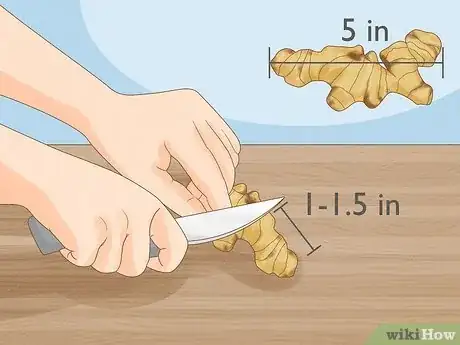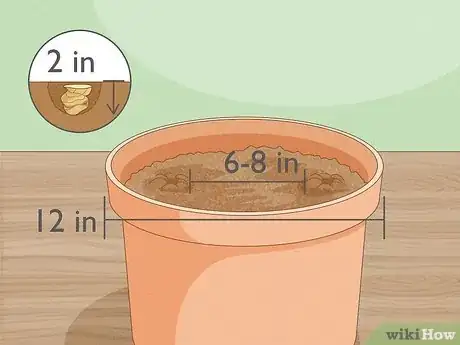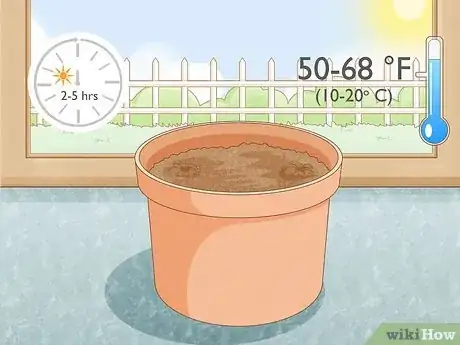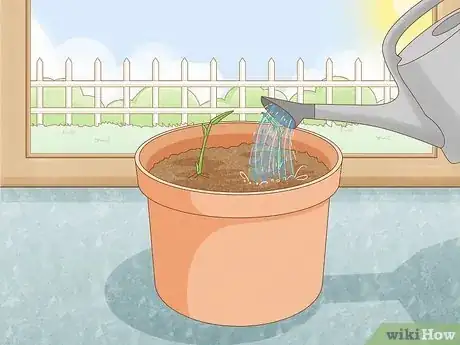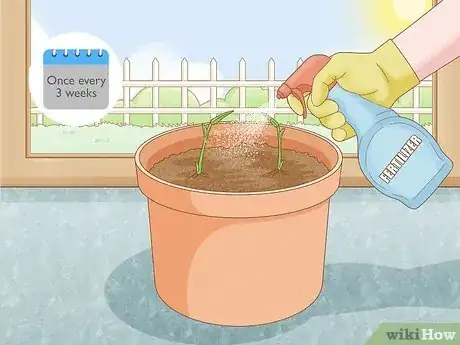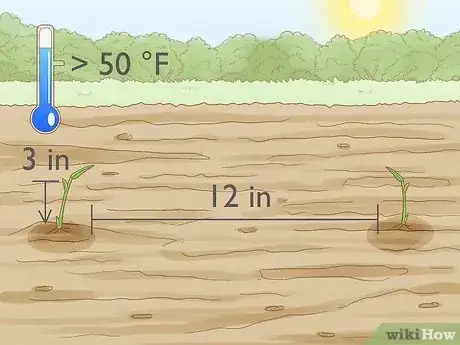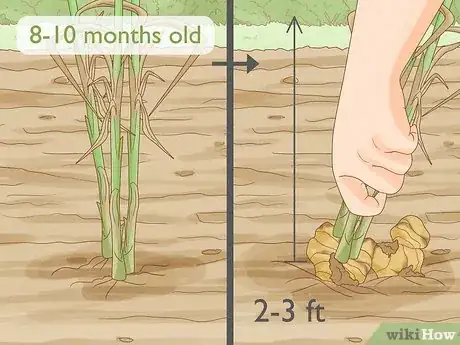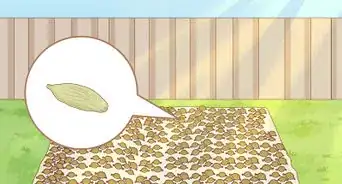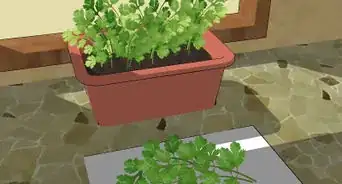This article was co-authored by Andrew Carberry, MPH and by wikiHow staff writer, Luke Smith, MFA. Andrew Carberry is a Food Systems Expert and the Senior Program Associate at the Wallace Centere at Winrock International in Little Rock, Arkansas. He has worked in food systems since 2008 and has experience working on farm-to-school projects, food safety programs, and working with local and state coalitions in Arkansas. He is a graduate of the College of William and Mary and holds a Masters degree in public health and nutrition from the University of Tennessee.
wikiHow marks an article as reader-approved once it receives enough positive feedback. This article received 72 testimonials and 92% of readers who voted found it helpful, earning it our reader-approved status.
This article has been viewed 1,821,101 times.
Growing ginger is easy and rewarding. The only thing between you and near-infinite, fresh ginger to eat whenever you like is simply a pot of soil and a root from your local grocer. Not to mention how good the leafy, tropical shoots tend to look in your home. Just pick up a ginger root from your nearest grocery store, and we’ll show you how to plant, grow, harvest, and propagate that root so that you’ll never have to buy store-bought ginger again.
Things You Should Know
- Cut a store-bought ginger root into 1–1.5 in (2.5–3.8 cm) pieces, with 1 or 2 knobby buds on each piece.
- Plant the pieces in a 12 in (30 cm) clay pot with nutrient-rich potting mix, and keep the soil moist but not too wet.
- Keep the ginger plants at about 68 °F (20 °C) in direct sunlight, and apply liquid fertilizer once every few weeks.
- Harvest your ginger when it’s 8-10 months old, digging up the entire plant, trimming off the shoots, and saving some root chunks for replanting.
Steps
Planting Ginger
-
1Purchase and cut a ginger rhizome into 1–1.5 in (2.5–3.8 cm) pieces. At your local grocer, select a root that’s firm and at least 5 in (13 cm) long, with several visible buds.[1] Then, cut the root into chunks (making sure each chunk has at least 1 bud) and leave the chunks on the counter for about 3 days to let them heal—the exposed inside will begin to callous over.[2]
- In addition, soak store-bought ginger rhizomes in water overnight to rinse off any anti-growth chemicals the grocer may have added.
- Cutting your ginger root into pieces allows for more opportunity to plant and grow a successful ginger plant.
- This guide covers Zingiber officinale. Most Zingiber species will grow under similar conditions, but for best results follow the nursery instructions.
-
2Plant each root chunk in a 12 in (30 cm) clay pot with nutrient-rich soil. Ginger thrives on high-quality, well-draining soil. Mix loamy potting soil with well-rotted compost or thick mulch.[3] Then, fill the pot with the soil, leaving about 1 inch (2.5 cm) of space at the top, and plant the ginger 2 inches (5.1 cm) beneath the surface, laid horizontally.[4]
- Alternatively, plant the chunks in a larger pot or in outdoor soil about 6–8 in (15–20 cm) apart.
- Like most garden plants, ginger prefers mildly acidic soils. If soil in your area is alkaline, adjust it to between 6.1 and 6.5 pH using a garden store pH kit.[5]
- If you’re planting outside in a seasonal climate, plant your ginger in mid-spring, since ginger is a tropical plant that does not survive frost. Plant after the last spring frost, or at the start of the wet season if you live in the tropics.[6]
Advertisement -
3Place the pot in direct sunlight, and water until the soil is moist. Ginger loves sunshine, so choose a spot that gets about 2-5 hours of direct sunlight each day.[7] In addition, make sure the spot stays at about 68 °F (20 °C) and doesn’t dip below 50 °F (10 °C). Then, water the soil until it’s moist but not outright wet or flooded.[8]
Growing Ginger
-
1Keep the soil damp. Check the soil daily and water just before it dries out completely. Soggy soil will quickly rot your plants, so reduce watering or move the plant to a pot with better drainage if water does not drain quickly[9] .
- In addition to regular watering, spray the aboveground portion of the plant about once a day with a spray bottle to keep it misted and hydrated in dryer climates.
-
2Fertilize the soil every few weeks after sprouts appear. Ginger typically takes about 3-8 weeks to break through the surface of the soil. Once you spot a sprout, apply liquid fertilizer to the soil (according to the instructions on the packaging) every 3 weeks to help the sprout grow tall and healthy.[10]
- In addition, add a thin layer of mulch to the surface of an outdoor ginger plant’s soil after sprouting to fend off weeds and retain water.[11] \
-
3Optionally, transplant your ginger as the seasons change. While not required, ginger benefits from some time outside its pot. Once the weather is consistently above 50 °F (10 °C), carefully dig your ginger out of its pot and plant it in your garden. Select a sunny spot with loamy soil similar to its potting soil, and plant the sprouts 3 in (7.6 cm) deep and about 12 inches (30 cm) apart, out of the wind. Then water as before.[12]
- Once the weather turns again, simply transplant the ginger shoots to their old pots using the same methods as before, and bring the pots inside.
- Test the soil with a pH kit and ensure it’s at a pH of about 5.5-6.5. If it’s not, add pH-adjusting fertilizer accordingly.
- When you see new shoots form or the rhizome peek out from the soil, add about 1 in (2.5 cm) of soil to the base of the plant.
Harvesting and Propagating Ginger
-
1Harvest your ginger once the shoots and leaves dry out. The stems of the ginger plant will turn yellow in late summer or early fall, as temperatures drop, or when the plant is about 8-10 months old. As soon as you see this, it’s time to harvest! Simply dig it up, rhizome and all from its pot or the earth.[13]
- A mature ginger plant will reach about 2–3 ft (0.61–0.91 m) in height.
-
2Cut away the shoots, and leave a few buds to replant. Trim the shoots off the rhizome so that it looks much like the way you bought it: a knobbly ginger root you might see in a grocery store. Then, cut as much of the rhizome as you’d like to keep for cooking or other purposes, leaving a few active buds behind for replanting. Rinse and refrigerate the ginger you’ll use, and set the other parts aside.[14]
- Store ginger for up to 3 weeks in the fridge, or about 6 months in the freezer.
-
3Replant the leftover ginger as before. Take your remaining ginger pieces and cut them into 2–3 in (5.1–7.6 cm) pieces, making sure each piece has 1 or 2 buds from which to send shoots. Then, plant these pieces in your 12 in (30 cm) pot with fresh potting soil, and enjoy your renewable source of fresh ginger! [15]
Expert Q&A
-
QuestionWhat kind of fertilizer should I use for ginger plants?
 Andrew Carberry, MPHAndrew Carberry is a Food Systems Expert and the Senior Program Associate at the Wallace Centere at Winrock International in Little Rock, Arkansas. He has worked in food systems since 2008 and has experience working on farm-to-school projects, food safety programs, and working with local and state coalitions in Arkansas. He is a graduate of the College of William and Mary and holds a Masters degree in public health and nutrition from the University of Tennessee.
Andrew Carberry, MPHAndrew Carberry is a Food Systems Expert and the Senior Program Associate at the Wallace Centere at Winrock International in Little Rock, Arkansas. He has worked in food systems since 2008 and has experience working on farm-to-school projects, food safety programs, and working with local and state coalitions in Arkansas. He is a graduate of the College of William and Mary and holds a Masters degree in public health and nutrition from the University of Tennessee.
Food Systems Expert The first step is to know the fertility/needs of your soil. When planting outdoors, you can mix in a slow-release organic fertilizer at initial planting, and either top-dress with compost or use a liquid fertilizer ever few weeks.
The first step is to know the fertility/needs of your soil. When planting outdoors, you can mix in a slow-release organic fertilizer at initial planting, and either top-dress with compost or use a liquid fertilizer ever few weeks. -
QuestionI have several ginger lilies planted that are now anywhere from 6" to 3' tall. The leaves are turning yellow on the tips and edges. They get full sun until mid-afternoon, and are watered everyday. Any suggestions?
 Community AnswerThey prefer partial shade. They are likely getting sunburned. They also need moist, but in well-draining soil. Transplant to a location that gets some shade, and make sure you aren't over-watering. Take a small amount of soil and squeeze it in your hand. It should hold its shape when you open your hand, but break easily when poked. If it doesn't hold its shape, the soil it too dry, but if it sticks to your hand like mud, it's too wet.
Community AnswerThey prefer partial shade. They are likely getting sunburned. They also need moist, but in well-draining soil. Transplant to a location that gets some shade, and make sure you aren't over-watering. Take a small amount of soil and squeeze it in your hand. It should hold its shape when you open your hand, but break easily when poked. If it doesn't hold its shape, the soil it too dry, but if it sticks to your hand like mud, it's too wet. -
QuestionCan I grow ordinary edible ginger purchased from vegetable shops?
 Community AnswerYes, it is possible to grow ginger this way.
Community AnswerYes, it is possible to grow ginger this way.
Warnings
- Stay on the lookout for prematurely yellowed or withered leaves, which are a sign of bacterial wilt or fusarium yellowing. Both are infectious plant diseases, and the best remedy is simply to unearth your ginger, dispose of it, and plant a new rhizome.⧼thumbs_response⧽
Things You'll Need
- Ginger rhizome
- Shears or knife
- Clay pot
- Potting soil
- Liquid fertilizer
References
- ↑ https://www.uvm.edu/news/story/growing-ginger-and-turmeric-indoors
- ↑ https://cdn-de.agrilife.org/extension/departments/hort/hort-pu-018/publications/files/easy-gardening-ginger.pdf
- ↑ https://cdn-de.agrilife.org/extension/departments/hort/hort-pu-018/publications/files/easy-gardening-ginger.pdf
- ↑ https://www.uvm.edu/news/story/growing-ginger-and-turmeric-indoors
- ↑ https://davesgarden.com/guides/pf/go/55488/
- ↑ https://hoke.ces.ncsu.edu/2020/03/growing-ginger-at-home-2/
- ↑ https://cdn-de.agrilife.org/extension/departments/hort/hort-pu-018/publications/files/easy-gardening-ginger.pdf
- ↑ https://www.uvm.edu/news/story/growing-ginger-and-turmeric-indoors
- ↑ https://www.uvm.edu/news/story/growing-ginger-and-turmeric-indoors
- ↑ https://cdn-de.agrilife.org/extension/departments/hort/hort-pu-018/publications/files/easy-gardening-ginger.pdf
- ↑ https://hoke.ces.ncsu.edu/2020/03/growing-ginger-at-home-2/
- ↑ https://extension.psu.edu/growing-ginger-add-a-little-spice-to-your-life
- ↑ https://www.uvm.edu/news/story/growing-ginger-and-turmeric-indoors
- ↑ https://hoke.ces.ncsu.edu/2020/03/growing-ginger-at-home-2/
- ↑ https://www.uvm.edu/news/story/growing-ginger-and-turmeric-indoors
About This Article
To grow your own ginger plant, look for a plump ginger root that is free of wrinkles, with visible buds, or eyes. After the danger of frost has passed, plant each piece of ginger 2-4 inches deep in a mixture of potting soil and rich compost, with the eyes pointing upward, then place it in a warm, shady spot. Once the ginger has sprouted, keep the soil moist and fertilize it once a month. Let the soil dry out as the stems die back in late summer or early fall, then harvest the ginger or bring it indoors for the winter. For tips on preparing the soil for your ginger plant, read on!
